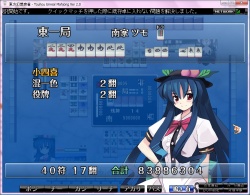Aotenjou: Difference between revisions
Jump to navigation
Jump to search
No edit summary |
|||
| Line 1: | Line 1: | ||
[[Image:Aotenjou.jpg|thumb|250px|right|Example aotenjou score.]] | |||
'''Aotenjou''' {{kana|青天井}} is a non-standard [[Scoring|scoring system]], by which all caps and limits are removed. Per the scoring equation: | '''Aotenjou''' {{kana|青天井}} is a non-standard [[Scoring|scoring system]], by which all caps and limits are removed. Per the scoring equation: | ||
: '''Basic points = fu × 2<sup>(2 + han)</sup>''' | : '''Basic points = fu × 2<sup>(2 + han)</sup>''' | ||
The basic points have the freedom to be valued as high as possible. Under aotenjou, scoring produces some ridiculously high numbers. | The basic points have the freedom to be valued as high as possible. Under aotenjou, scoring produces some ridiculously high numbers, as there is essentially no limit. Han is factored exponentially in the equation. Points are even much higher in conjunction with the multipliers applied for the dealer, non-dealer, and ron vs. tsumo wins. Hence, for this reason, the scoring limits imposed by both mangan and yakuman are normally used. Also, [[yakuman]] patterns are defaulted at 13 han. | ||
== Extreme scoring examples == | == Extreme scoring examples == | ||
Revision as of 09:04, 7 August 2014

Aotenjou 「青天井」 is a non-standard scoring system, by which all caps and limits are removed. Per the scoring equation:
- Basic points = fu × 2(2 + han)
The basic points have the freedom to be valued as high as possible. Under aotenjou, scoring produces some ridiculously high numbers, as there is essentially no limit. Han is factored exponentially in the equation. Points are even much higher in conjunction with the multipliers applied for the dealer, non-dealer, and ron vs. tsumo wins. Hence, for this reason, the scoring limits imposed by both mangan and yakuman are normally used. Also, yakuman patterns are defaulted at 13 han.